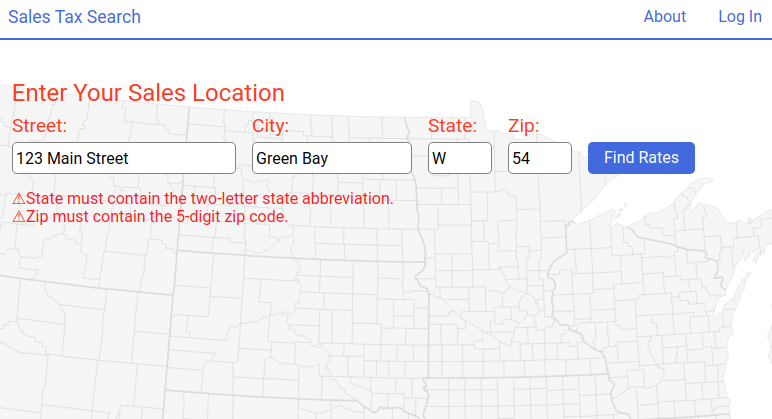Sales Tax Search is a web application designed to assist tax preparers and accountants with the often tedious task of looking up sales tax rates.
This is the second version of the app. The first version does not use React or any front-end frameworks or routing libraries. Here's the link to it: https://github.com/michaelsinghurse/sales-tax-search.
The app was built with Create React App. All
the HTML files are generated at build time with the npm run build command and
served from the ./client/build folder.
Client-side routing is managed by React-Router.
The server uses the Express framework. It has three
primary responsibilities: allow incoming requests to use the
./client/build folder for static resources, respond to requests to
the API endpoint for tax rates and political jurisdictions, and provide a
catch-all response to all other requests by sending the index.html file.
One challenge I faced was about how to validate form values.
The code for the form can be found in ./client/src/SearchForm.js.
React has the concept of "controlled component", which is a form element whose value is controlled by React rather than the element itself. Instead of a form element maintaining its own state internally, React maintains the state and renders it whenever the state changes. React is said to be the source of truth for the element.
Because React is maintaining the state of the form elements, I didn't rely on
browser form validation via the pattern or required attributes.
I went about validating the form inputs in two ways:
- On input change. Whenever a form input value changes, I run the new value through a validation function. The validation function returns either an error message or an empty string (an empty string means that the value is valid). I then set the state of the React component with the new input value and the validation error message. If there was an error, it will be rendered directly below the form, as shown below.
Note: I should give credit here to Eric Bishard for his article about React form validation. I leaned on it heavily to set up my validation logic and for rendering the error message.
- On form submit. When the user submits the form, I prevent the default action of the browser handling the submit. I gather the value of every input element and run each of them through the validation function. If any input value produces an error message, I set the state of the React component with the new input values and error messages and return immediately. I don't send a request to the server or reset the form. On the other hand, if all of the input values are valid, I send a fetch to the server for the tax rates and political jurisdictions for the address entered and reset the form.
Once again, all my code for the form can be found in the file
./client/src/SearchForm.js.
- Michael Singhurse
- michaelsinghurse@gmail.com
